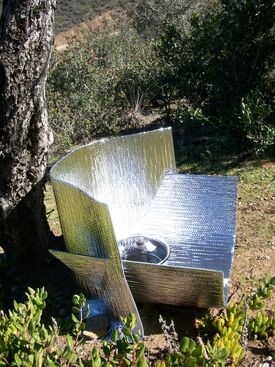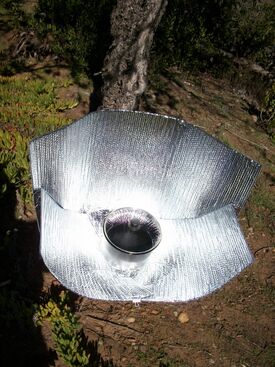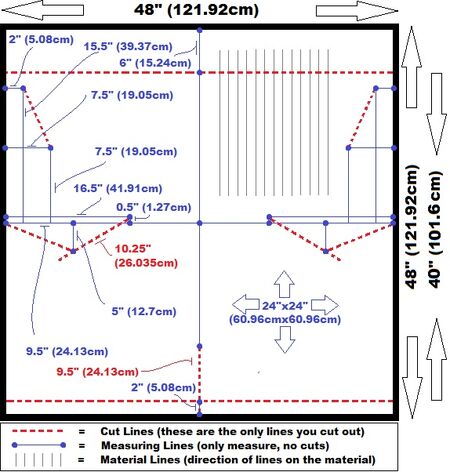Paul Hedrick (talk | contribs) No edit summary |
RogerHaines (talk | contribs) No edit summary |
||
| (47 intermediate revisions by 5 users not shown) | |||
| Line 1: | Line 1: | ||
| + | {{GoogleTranslateLinks}} |
||
| − | [[File:Haines_Cooker_(Front).jpg|right|300px]] |
||
| + | |||
| + | |||
[[File:Haines_Cooker_(Side).jpg|right|300px]] |
[[File:Haines_Cooker_(Side).jpg|right|300px]] |
||
| − | [[File:Haines_Windscreen.jpg|thumb|300px|The cooker is shown with an added clear nylon cover to help in windy conditions.]] |
||
[[File:Haines_Polycarbonate_Sleeve.jpg|thumb|300px|The '''Haines Polycarbonate Sleeve '''eliminates the nylon cooking bag commonly used in solar cooking.]] |
[[File:Haines_Polycarbonate_Sleeve.jpg|thumb|300px|The '''Haines Polycarbonate Sleeve '''eliminates the nylon cooking bag commonly used in solar cooking.]] |
||
| + | [[File:Haines_Cooker_Template.jpg|thumb|450px]] |
||
| − | The [[Haines Solar Cooker]] combines the power of a [[Funnel cooker]] with stability of the traditional [[CooKit]]. It has been designed by Roger Haines of San Diego, {{state|California}}, [[USA]]. The cooker is made from a mylar-coated bubble insulation material which is unaffected by boiling water, so it should be more durable than a cardboard design. It requires only two cuts for cooker assembly. Testing has shown it to maintain hotter temperatures than the CooKit. . |
||
| ⚫ | |||
| + | This article describes the original [[Haines Solar Cooker]], designed in 2013 by Roger Haines of San Diego, {{state|California}} [[USA]]. Roger has a new design with more durable materials, called the Haines II Solar Cooker. See http://solarcooking.wikia.com/wiki/Haines_Foam_Insulation_Cooker. Nevertheless, the original Haines cooker was made in the USA from aluminum-coated reflective bubble insulation material that is sold "off-the shelf" at Lowe's Home Centers in 4-foot by 25-foot rolls. The material can still be ordered on-line in the US under different brand names, and is also available in Europe, India and China. The cooker was made from a single 48" by 48" rectangle of bubble material, and required only three cuts with ordinary scissors for cooker assembly. In testing in San Diego, this cooker heated an empty pot to a sustained 380 degrees Fahrenheit (193 degrees Celsius) and heated a liter of water from room temperature to boiling in less than an hour. |
||
| + | The two curves of the cooker form an oval funnel that focuses the sun's rays on the cooking pot. The base of the cooker was anchored with rocks or bricks as shown in the photo. <span style="font-family: "Cambria","serif"; font-size: 11pt; mso-ascii-theme-font: major-latin; mso-fareast-font-family: Calibri; mso-fareast-theme-font: minor-latin; mso-hansi-theme-font: major-latin; mso-bidi-font-family: Arial; mso-ansi-language: EN-US; mso-fareast-language: EN-US; mso-bidi-language: AR-SA;">On windy days, the bottom curve of the cooker could be prevented from being blown upward, by wrapping a circle of string around each side of the curve, and securing the string with the same brick or rock that is used to hold down the cooker.<span style="mso-spacerun: yes;"> When the sun was high, the cut at the front bottom of the cooker could be overlapped and clipped together with a binder clip to form a kind of parabola to concentrate more sun on the cooking pot. |
||
| − | The base of the cooker should be anchored with rocks or bricks. In windy conditions, an oval wind screen made of clear nylon plastic makes it quite stable while protecting the cooking pot from the wind. |
||
| + | |||
| ⚫ | The '''Haines Polycarbonate Sleeve '''eliminates the nylon cooking bag commonly used in solar cooking. This sleeve is a 16 cm x 92 cm (6" x 36") rectangle of UV-stabilized polycarbonate plastic film (.020"), such as Bayer Bayfol UV-1-72, or Lexan 8030, rolled into a cylinder to enclose the bottom and sides of the pot but not the top. The cylinder is held together with jumbo paper clips, thus allowing its diameter to be adjusted to fit a variety of cooking pots The pots must be round, with no handles, and must have a top rim that can rest on the top of the cylinder. The cylinder elevates the pot above the surface of the cooker, allowing the sun's rays to bounce off the reflective surface of the cooker and be absorbed by the bottom of the cooking pot. It also provides an insulating "greenhouse" making a traditional cooking bag unnecessary. Haines's testing indicates that a pot with a glass lid retains more heat than one with a metal lid. |
||
| + | |||
| + | See also http://solarcooking.wikia.com/wiki/Haines_Foam_Insulation_Cooker. [[File:Haines_II_pot&sleeve.jpg|thumb|Haines II Foam Insulation Solar Cooker]] |
||
| + | {{clr}} |
||
| + | |||
| + | |||
| + | |||
| + | ==Kirkpatrick Solar Cooker (Kirk-ook) variation== |
||
| + | [[File:Kirk-Cook_(L-Side)_(480x640).jpg|thumb|275px|The bottom reflector slots into the rear reflector of the Kirk-ook variation]] |
||
| + | [[File:Kirk-Cook_(Top)_(480x640).jpg|thumb|275px|Kirk-ook variation]] |
||
| + | [[File:Kirk-Cook_(48x40).jpg|thumb|450px|Kirk-ook construction template]] |
||
| + | Mark Evans Kirkpatrick has offered a modified, more efficient version known as the [[Kirk-ook]] for less than $4.20USD. He improved the design when conducting a [http://www.matchinggrants.org/district/project153.html joint project] between his Rotary Club,[http://sdcoastalrotary.org/ San Diego Coastal], and a [http://rotarysandiego.org/ Rotary District 5340] project partner. [http://www.matchinggrants.org/district/project153.html The project] consisted of 291 [http://en.wikipedia.org/wiki/Solar_cooker solar cookers], called "Rotary District 5340 Cookers" (Haines design) sent to the [http://www.clubrunner.ca/cprg/Bulletin/SendBulletinEmail.aspx?cid=9496 Nairobi Mashariki Rotary Club] of [http://www.rotaryeastafrica.org/index.asp District 9212 in Kenya]. |
||
| + | |||
| + | About the [[Kirk-ook]]: The [http://www.homedepot.com/p/Reflectix-4-ft-x-25-ft-Double-Reflective-Insulation-BP48025/100052556?N=19n#.UiYPTz8lKAo base reflector] is slotted through the [http://www.homedepot.com/p/Reflectix-4-ft-x-25-ft-Double-Reflective-Insulation-BP48025/100052556?N=19n#.UiYPTz8lKAo rear reflector] to provide more stability for the cooker in windy conditions (with less base material extended and more base material supported). The bottom-rear of the cooker can be supported with rocks as shown in the picture. By extending the sides you will create a [http://en.wikipedia.org/wiki/Wave-formed_ripple wave-formed ripple ]focusing more rays in the center for higher effectiveness (depending on the angle of the sun). Higher temperatures can be reached using a [http://www.reynoldskitchens.com/products/oven-bags/turkey-oven-bags/ turkey bag] around the pot & lid or split and covering the Kirk-ook on windy days (alleviating [http://www.solarcooker-at-cantinawest.com/cooking-in-the-wind-question-answer.html the effect from high winds known as wind chill]) . The [http://www.curbellplastics.com/technical-resources/pdf/polycarbonate-film-bayfol-UV1-7-2.pdf plastic film] can be coated with [http://www.bpf.co.uk/plastipedia/additives/default.aspx UV agents] to avoid discoloration and distortion. Alternate transparent plastics are being tested for higher heat resistance (*email suggestions). It is recommended using [http://www.walmart.com/ip/Office-Impressions-HEAVY-DUTY-BOX-SEALING-TAPE-2-X-55-YARDS-3-CORE-CLEAR-2-Pack/19487664?action=product_interest&action_type=title&placement_id=irs_top&strategy=PWVAV&visitor_id=47961395468&category=0%3A3944%3A546952%3A1046059%3A1065165&client_guid=68c5ab53-1bf2-4092-9ad9-6342678fa378&config_id=2&parent_item_id=14935484&guid=78f4bd0d-df12-464b-bf21-1ad18c1ec466&bucket_id=000&findingMethod=p13n clear packaging tape] to cover each area that is cut (easier when applied prior to cutting out the design) on each side of the cooker. Tape can also be added to other areas prone to wear-and-tear (mainly the latching triangles that connect the [http://www.homedepot.com/p/Reflectix-4-ft-x-25-ft-Double-Reflective-Insulation-BP48025/100052556?N=19n#.UiYPTz8lKAo base and rear relector]). |
||
| + | {{clr}} |
||
| ⚫ | The '''Haines Polycarbonate Sleeve '''eliminates the nylon cooking bag commonly used in solar cooking. This sleeve is a |
||
| − | [[File:Template_for_Haines_Cooker.jpg|thumb|400px|Template for Haines Cooker]] |
||
| ⚫ | |||
==See also== |
==See also== |
||
*[[CooKit]] |
*[[CooKit]] |
||
| + | *[[Windshield Shade Solar Cooker]] |
||
==Contact== |
==Contact== |
||
| − | + | {{See|Roger Haines}} |
|
| + | |||
| − | Roger Haines |
||
| + | Re: Kirk-ook |
||
| + | |||
| + | Mark Evans Kirkpatrick |
||
| + | E: [http://markevanskirkpatrick@gmail.com markevanskirkpatrick@gmail.com] |
||
| − | Tel.: +1 (858) 736-5505<br /> |
||
| − | Email: [mailto:bhaines@san.rr.com bhaines@san.rr.com] |
||
[[Category:Solar cooker designs]] |
[[Category:Solar cooker designs]] |
||
[[Category:Solar panel cooker designs]] |
[[Category:Solar panel cooker designs]] |
||
| + | [[Category:Solar panel cooker plans]] |
||
| + | [[Category:Solar cooker plans]] |
||
Revision as of 22:59, 29 April 2014

The Haines Polycarbonate Sleeve eliminates the nylon cooking bag commonly used in solar cooking.


Assembly diagram for the Haines Cooker
This article describes the original Haines Solar Cooker, designed in 2013 by Roger Haines of San Diego, California USA. Roger has a new design with more durable materials, called the Haines II Solar Cooker. See http://solarcooking.wikia.com/wiki/Haines_Foam_Insulation_Cooker. Nevertheless, the original Haines cooker was made in the USA from aluminum-coated reflective bubble insulation material that is sold "off-the shelf" at Lowe's Home Centers in 4-foot by 25-foot rolls. The material can still be ordered on-line in the US under different brand names, and is also available in Europe, India and China. The cooker was made from a single 48" by 48" rectangle of bubble material, and required only three cuts with ordinary scissors for cooker assembly. In testing in San Diego, this cooker heated an empty pot to a sustained 380 degrees Fahrenheit (193 degrees Celsius) and heated a liter of water from room temperature to boiling in less than an hour.
The two curves of the cooker form an oval funnel that focuses the sun's rays on the cooking pot. The base of the cooker was anchored with rocks or bricks as shown in the photo. On windy days, the bottom curve of the cooker could be prevented from being blown upward, by wrapping a circle of string around each side of the curve, and securing the string with the same brick or rock that is used to hold down the cooker. When the sun was high, the cut at the front bottom of the cooker could be overlapped and clipped together with a binder clip to form a kind of parabola to concentrate more sun on the cooking pot.
The Haines Polycarbonate Sleeve eliminates the nylon cooking bag commonly used in solar cooking. This sleeve is a 16 cm x 92 cm (6" x 36") rectangle of UV-stabilized polycarbonate plastic film (.020"), such as Bayer Bayfol UV-1-72, or Lexan 8030, rolled into a cylinder to enclose the bottom and sides of the pot but not the top. The cylinder is held together with jumbo paper clips, thus allowing its diameter to be adjusted to fit a variety of cooking pots The pots must be round, with no handles, and must have a top rim that can rest on the top of the cylinder. The cylinder elevates the pot above the surface of the cooker, allowing the sun's rays to bounce off the reflective surface of the cooker and be absorbed by the bottom of the cooking pot. It also provides an insulating "greenhouse" making a traditional cooking bag unnecessary. Haines's testing indicates that a pot with a glass lid retains more heat than one with a metal lid.
See also http://solarcooking.wikia.com/wiki/Haines_Foam_Insulation_Cooker.

Haines II Foam Insulation Solar Cooker
Kirkpatrick Solar Cooker (Kirk-ook) variation

The bottom reflector slots into the rear reflector of the Kirk-ook variation

Kirk-ook variation

Kirk-ook construction template
Mark Evans Kirkpatrick has offered a modified, more efficient version known as the Kirk-ook for less than $4.20USD. He improved the design when conducting a joint project between his Rotary Club,San Diego Coastal, and a Rotary District 5340 project partner. The project consisted of 291 solar cookers, called "Rotary District 5340 Cookers" (Haines design) sent to the Nairobi Mashariki Rotary Club of District 9212 in Kenya.
About the Kirk-ook: The base reflector is slotted through the rear reflector to provide more stability for the cooker in windy conditions (with less base material extended and more base material supported). The bottom-rear of the cooker can be supported with rocks as shown in the picture. By extending the sides you will create a wave-formed ripple focusing more rays in the center for higher effectiveness (depending on the angle of the sun). Higher temperatures can be reached using a turkey bag around the pot & lid or split and covering the Kirk-ook on windy days (alleviating the effect from high winds known as wind chill) . The plastic film can be coated with UV agents to avoid discoloration and distortion. Alternate transparent plastics are being tested for higher heat resistance (*email suggestions). It is recommended using clear packaging tape to cover each area that is cut (easier when applied prior to cutting out the design) on each side of the cooker. Tape can also be added to other areas prone to wear-and-tear (mainly the latching triangles that connect the base and rear relector).
See also
Contact
- See Roger Haines.Roger Haines
Re: Kirk-ook
Mark Evans Kirkpatrick

